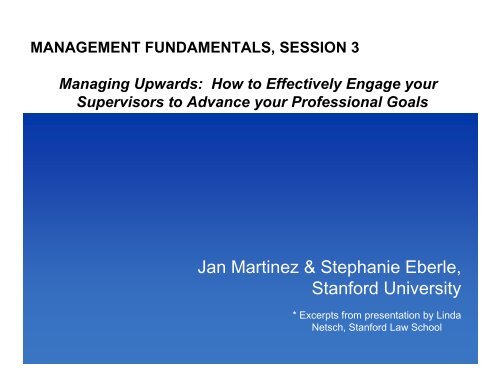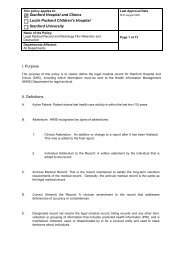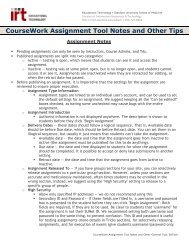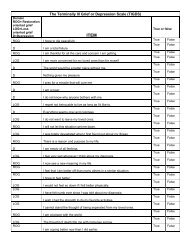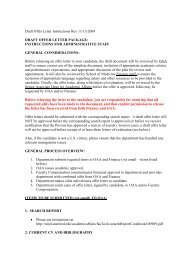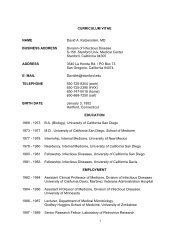MANAGEMENT FUNDAMENTALS, SESSION 3 Managing Upwards
MANAGEMENT FUNDAMENTALS, SESSION 3 Managing Upwards
MANAGEMENT FUNDAMENTALS, SESSION 3 Managing Upwards
Create successful ePaper yourself
Turn your PDF publications into a flip-book with our unique Google optimized e-Paper software.
<strong>MANAGEMENT</strong> <strong>FUNDAMENTALS</strong>, <strong>SESSION</strong> 3<br />
<strong>Managing</strong> <strong>Upwards</strong>: How to Effectively Engage your<br />
Supervisors to Advance your Professional Goals<br />
Jan Martinez & Stephanie Eberle Eberle,<br />
Stanford University<br />
* Excerpts from presentation by Linda<br />
Netsch, Stanford Law School
Learning Goals:<br />
• Exploration of the most common “difficult”<br />
conversations and why they’re so difficult<br />
• Understanding of the most common behavior<br />
patterns when giving/receiving feedback<br />
• Recommendations on how to develop better patterns<br />
to effectively y manage g upwards p<br />
.<br />
Anything else?
Your Difficult Conversations<br />
• Focus on conversations which YOU<br />
experience as very difficult – for whatever<br />
reason<br />
• Conversations which you either avoid or<br />
tend to manage g badly y – or both<br />
• Explore what makes those conversations<br />
difficult for you<br />
.
1 st Things First<br />
•AA word about confidentiality….<br />
•Give feedback and/or respond to feedback<br />
for the r-i-g-h-t reasons<br />
•Know K yourself lf and d your patterns tt<br />
•“Practice Practice makes perfect” perfect<br />
•Know your y<br />
ABC’s<br />
.
The ABC’s of Assertiveness<br />
Action<br />
Blif Belief<br />
CConsequence<br />
.
.<br />
Wh What is i assertiveness i<br />
to you?
Common Behavior Patterns<br />
•Passive<br />
•Aggressive<br />
•Passive Aggressive<br />
•Assertive<br />
.
How Do I Know Where I’m At?<br />
Monitor Your “Zones” Carefully<br />
Comfort Zone: Where the person with whom you work is<br />
most comfortable<br />
Zone of Intolerance: Where you feel most comfortable<br />
Zone of Tolerance: Both parties feel a little discomfort<br />
but it is a tolerable amount of discomfort<br />
.<br />
Created and Consolodated by:<br />
Stephanie K. Eberle
Barriers to Assertive Behavior Pattern?<br />
Cultural differences<br />
Organizational “rules”<br />
Gender role stereotypes<br />
Not Not being prepared<br />
Low self-esteem<br />
Belief that there is no choice in the matter<br />
Lack of assertiveness on others’ parts<br />
Old habits die hard!<br />
.
To Assert or Not?<br />
.<br />
It’s It s your choice!<br />
But, , how?
In Difficult Conversations<br />
.<br />
Effective<br />
Less Effective
.<br />
Key Skills<br />
You must effectively y engage g g what<br />
they are really thinking and<br />
feeling.<br />
And And, you must manage what you<br />
are thinking g and feeling. g
Three Aspects of Difficult Conversations<br />
.<br />
What Happened?<br />
Who’s right? Whose fault?<br />
What are their intentions?<br />
Feelings<br />
What do we do with the<br />
strong feelings we have?<br />
Identity<br />
How does this situation<br />
challenge my self-<br />
perception ti and d theirs?<br />
th i ?
“What Happened?” - 3 Helpful Shifts<br />
Truth Perceptions<br />
Blame Contributions<br />
Intent = Impact Intent ≠ Impact<br />
.
Distinguishing<br />
Observations From Assessments<br />
Observations vs. Assessments<br />
An Observation is<br />
neutral, clear, and<br />
specific - is usually<br />
either true or false<br />
.<br />
Copyright © 2010 by Mobius. All rights reserved.<br />
An Assessment is a<br />
statement of opinion and<br />
perception<br />
Assessments are<br />
neither true nor false -<br />
they express a judgment<br />
Mobius Executive Leadership | 15
Observations vs. Assessments<br />
• John fails to get people to deliver on<br />
time.<br />
• John’s presentation was due on<br />
Wednesday but was not finished until<br />
Friday.<br />
• Two members of John’s team were not<br />
aware of the Wednesday deadline.<br />
.<br />
Copyright © 2010 by Mobius. All rights reserved.<br />
Mobius Executive Leadership | 16
Ladder of Inference<br />
.<br />
DATA<br />
Conclusions<br />
The bottom line, e.g., “You handled that so<br />
badly.”<br />
Reasoning & Interpretations<br />
Why? What’s my underlying reasoning?<br />
Selected Data<br />
What data is my conclusion based on?<br />
What do I notice? What do I ignore?<br />
What might they know that I don’t know?<br />
Developed by Chris Argyris of Harvard Business School and Don Schon of MIT
Explore Different Perceptions<br />
Their My<br />
Ladder Ladder<br />
Conclusions Conclusions<br />
Reasoning Reasoning<br />
.<br />
DData t<br />
Data
.<br />
Blame to<br />
Contributions
.<br />
Blame vs. Contributions<br />
Whose Fault?<br />
My Contribution<br />
Your Contribution<br />
Wh What t<br />
Punishment?<br />
Improve<br />
Together<br />
Blame<br />
Contributions
Common, Less Obvious Contributions<br />
• Not listening<br />
• Not saying anything until now<br />
• Being unapproachable<br />
• Being unclear<br />
• Presenting mixed messages…content/tone<br />
• Choosing a mode of communication that didn’t get<br />
through (voicemail, e-mail)<br />
• Not providing appreciation or feedback<br />
.
Contributions<br />
Most Problems Result From More Than One<br />
Factor<br />
• Share how you see the problem<br />
• Take responsibility for your own contribution<br />
• Ask how they see the problem and<br />
contributions<br />
• Ask ho how you o can each change your o r<br />
contributions to improve<br />
.
Intentions and Impact<br />
.<br />
Intentions matter. matter But other people’s people s<br />
intentions are invisible to us<br />
SSo we make k up attributions tt ib ti about b t their th i<br />
intentions based on the impact on us<br />
We often assume the worst<br />
WWe sometimes ti miss i our iimpactt on th them.
Disentangling Intent and Impact<br />
• What we do know:<br />
• Our own intentions (positive, neutral,<br />
negative)<br />
• The impact of their behavior on us<br />
• What we don’t know:<br />
.<br />
• Their intentions<br />
• The impact of our behavior on them
Advice<br />
•Let Let go of knowing or proving their intentions.<br />
•Be clear about your own intentions - decide<br />
whether to share.<br />
•Explain E l i negative ti impacts i t on you without ith t<br />
attributing bad intentions.<br />
•Listen for and acknowledge the negative<br />
impacts p they y experienced.<br />
p<br />
.
Advice On Communicating Decisions<br />
.<br />
Don’t Leave an Intentions Vacuum<br />
People fill an intentions vacuum with negative<br />
attributions<br />
When decisions are made:<br />
D Don’t ’t assume others th will ill understand d t d your<br />
intentions<br />
Offer data and reasoning<br />
Explain why choices that may appear more<br />
attractive were discarded
Helpful Phrases<br />
• “No”<br />
• “I know that you are saying this because you care,<br />
but I don’t believe it is best for me”<br />
• “What I am saying is….”<br />
• “I am going to need to think about this and get back<br />
to you”<br />
• “When you say this, I feel…”<br />
• “In In working with your busy schedule, schedule let me know<br />
when/where/how we will next be able to meet”<br />
.
Putting Theory into Practice<br />
.<br />
PI/P PI/Post-doc t d<br />
SScenario i
Quick Tips: Giving Feedback/Confronting<br />
a Problem<br />
• Start with clarification not assumptions<br />
• Be specific<br />
• Use “I” statements<br />
• Confront the problem right g away y and in person<br />
• Discuss one problem at a time<br />
• Gently point out inconsistencies<br />
• Acknowledge g feelings g and responses p<br />
nonjudgementally<br />
• Offer ideas for change or explain possible<br />
consequences q<br />
• Avoid power struggles or being manipulated into<br />
giving positive feedback<br />
.
Quick Tips: Responding to Feedback and<br />
Confrontation<br />
• It’s not always personal!<br />
• Pay attention to the message, not the format<br />
• Ask for specifics<br />
• Talk to someone you y trust about the feedback ( (not<br />
for the purpose of gossip)<br />
.
“Special” Circumstances<br />
• Salary y Negotiation g<br />
• Overt Aggression, Borderline Violence<br />
• Sexual Harassment<br />
.<br />
ANYTHING ELSE?
“Special” Circumstances: Taking CARE of<br />
You<br />
C ut it off<br />
A ssert yourself<br />
R eport<br />
E vacuate and/or Elevate<br />
.
Resources:<br />
•Assertiveness Assertiveness resources handout<br />
•Ombudsman Office or department head<br />
•Other managers/professors<br />
•Counseling and mediation are always<br />
options<br />
.
Questions?<br />
Next Week: Negotiation<br />
.<br />
Theory and Practice I


